#It's only videos in /reference/ to Evo or where he /talks/ about Evo but absolutely not a one of Evo itself
Text
I just wanted to rewatch some Buildswaps whyyyyyy
#Crying update#Lol#Grian: *talks about Evo* Me immediately: *crying*#FJkkdslafdf well now I have to go rewatch the uhhhhh redstone/buildswap thingy as well?? 'Cause I remember him mentioning it there too#I just need to rewatch Evo itself so I can get all my crying out geez#Evo didn't even make me cry that much!!#There aren't even any Evo videos in my crying playlist!#Which yes of course I have that lol#It's only videos in /reference/ to Evo or where he /talks/ about Evo but absolutely not a one of Evo itself#Sheesh and sheesh#Evo SMP
2 notes
·
View notes
Text
First Take Review: Gryphon Essence Preamplifier & Stereo Amplifier
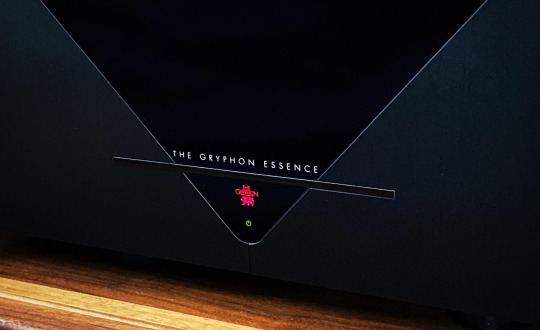
Okay, let’s get this out of the way: with a combined retail of over USD $40k (and that doesn’t include another $6k for the optional Zena DAC module), The Gryphon’s Essence preamplifier and stereo amplifier are by far the most expensive electronics I’ve ever had in my home! They might be the Danish firm’s entry point into separates, but that’s akin to calling a $146k Aston Martin Vantage “entry level.” There was a time in the not-so-distant past when spending such sums of money on stereo gear struck me as pointless excess. Perhaps I’ve been numbed by flipping through too many issues of The Absolute Sound or walking the halls of an audio show; perhaps I’m just entering a life stage (mid-life crisis, anyone?) where I’m allowing myself to indulge in such luxuries. Whatever the case may be, I’ve now had the good fortune of several months with the Essence combo, and despite a number of people prodding me for this review it’s been quite difficult to put into words how they perform. Why? Because every time I sit down to do the “work” of reviewing I just end up getting sucked into the music and forget to do the reviewing bit! But, here goes...
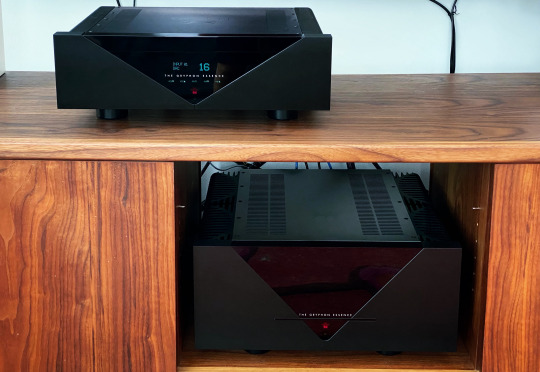
The arrival of the Gryphon components was a case of one thing leading to another. My first experience was when I strolled into Gryphon’s room at RMAF 2018. After being disappointed by so many other mega-buck systems at the show, I was delighted that this one actually sounded like music! Frankly, a lot of über-expensive show systems landed on my ears like amusical hi-fi effects or whimsical fancies of what some people think music should sound like, rather than an actual musical performance. Like other big systems, the Gryphon rig was imposing and fancy-looking, but with a decidedly purposeful, even stark, aesthetic. And the sound - so tangible and luscious, maybe a little dark and brooding, but in a way that connected me emotionally to the recorded performance rather than distracting me with sonic affect.
At the time I was happily running the Valvet A4 Mk.II monoblocks, and also had @mgd-taww’s Pass Labs XA30.5 at my disposal. Both delivered the pure and colorful musical flavors of Class A amplification, and both are superb amps. But things got thrown for a bit of a loop when I settled on the Audiovector SR 6 Avantgarde Arreté speakers as my new reference. I had auditioned them at AudioVision SF with the Gryphon Diablo 300 integrated amp ($16k) and the sound gave up nothing to high-quality separates - big, bold and dynamic with tremendous poise and nuance. Coming back to the Pass and Valvet amplifiers (coupled with a Pass Labs XP10 line stage) certainly wasn’t a let-down, but they didn’t have quite the same level synergy with the Audiovectors which sounded more complete and visceral with the Gryphon integrated.
This combined with the strong aural memories from the RMAF room led to a call to Gryphon’s US distributor, Philip O’Hanlon and Pandora Pang of On a Higher Note. Philip acknowledged that the Diablo was indeed excellent but teased that Gryphon had recently introduced a new line of separates worth consideration. The Essence had just arrived in the States and he had one more set in stock if I were so inclined... and next thing I know, a pallet loaded with what my wife lovingly referred to as “an illegal arms shipment” landed at our doorstep.

Serious crates for serious gear
Like all separates in The Gryphon’s 35-year heritage dating back to the original DM100 amplifier, the Essence line features pure Class A operation with minimal negative feedback, but brings it at a lower price point ($22,990) with more conservative aesthetics and practical packaging. Prior to the Essence, to get a Gryphon amp one had to shell out anywhere from $39k for the Antileon EVO to $57k for the flagship Mephisto (double those if going for monoblocks). The tradeoff is a lower power rating - just 50wpc, albeit in pure class A and doubling into 4 ohms and again into 2 ohms - so you’ll want to pair it with a reasonably efficient speaker. The Essence preamp meanwhile is a repackaging of the Zena preamplifier launched in 2018 (also $17,500), reskinned with cosmetics to match the amp. It features fully balanced operation via a discrete DC-coupled Class A circuit with zero global negative feedback, and can accommodate either of two optional internal modules, the Zena DAC ($6,000) or an MM/MC phono stage ($2,250). Being strictly digital I opted to evaluate the DAC, which I’ll talk about in a later installment. I’ll also save more details about the design and operation of this beautifully-crafted gear, including Gryphon’s unique Green Bias system, for a more in-depth review. For now, let’s get down to the business of how it sounds...
The Essence Preamp
When the Essence components arrived I clearly needed my wife’s assistance to safely unpack and set up the 45kg/99lb Essence amp. But she was busy making reeds for her oboe that evening, so I initially made do setting up the preamp (it weighs in at “only” 13.4kg/29.5lbs) and comparing it to my Pass Labs XP10 with the Pass Labs XA30.5 amplifier.
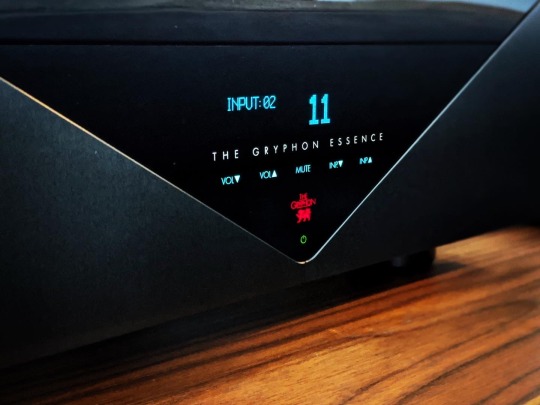
Firing up the Essence preamp from a cold start was one of those “damn, I don’t understand how a preamp can make this much of a difference” moments. Even though the Pass XP10 is a very solid performer - I find the sound of my PS Audio DirectStream significantly improved by it vs. feeding an amplifier directly - the 3x-as-expensive Gryphon outclassed it from the first note, taking musical resolution from the micro to nano level.
The first thing I noticed was how the entire back of the stage opened up. I never realized how triangular it sounded before, becoming narrower as you went deeper. With the Essence it suddenly feels rectangular and whole, with winds, brass and percussion able to naturally spread out and breath on the stage. It didn’t even take a big orchestral recording to experience this - my very first track was an intimate vocal with piano accompaniment, soprano Elsa Dreisig singing Strauss songs with pianist Jonathan Ware (Qobuz). The sense of the space - a church, as you can see from this video - and where the performers occupied it became strikingly tangible. Piano has starting clarity, with all its complex overtones unfolded and laid out for your ear to sample at its leisure. Dynamic resolution is also unlocked - subtle gradations in vocal intensity flow so organically. Going back to the Pass pre, macro dynamics weren’t Iacking, but the transitions somehow came across more synthetically, as if the volume dial was being turned rather than the performers modulating their instruments in the original performance.

One thing that didn't change too much was overall tonal balance. I find the Pass pretty neutral and extended, if anything having a subtly warmish character to it, at least by solid state standards. The Gryphon doesn't deviate notably from that, leaning slightly in that direction though with more sophisticated and varied tonal richness and density. The quality of the frequency extremes, however, is a different matter. Most striking is how triangles sparkle and ring with startling presence on the Gryphon. With a claimed frequency response out to 1MHz, the Essence pre delivers the highest highs with a sense of ease and finesse. And the bass is everything people have come to expect from the Gryphon house sound - deep, taut and powerful with beautiful tonality. The Pass Labs wasn’t missing any of the music per se, but the deepest bass notes and highest overtones sounded constrained vs. the effortless and wide-open delivery of the Essence.
So, yeah - a preamplifier that costs 3x as much as the Pass XP10 sounds clearly superior. Not much of a news flash, and a much fairer comparison in the Pass lineup would be the XP32 ($17,500) or at least an XP22 ($9,500). But what took me aback was how a preamplifier like the Essence could bring out so much life and nuance that was being curtailed by an otherwise fine piece like the Pass. The net effect was to make the musical performance feel significantly more tangible, visceral and unclouded - something that even the change of a DAC or amplifier doesn’t consistently achieve. The Gryphon Essence pre is simply an incredible conveyor of the musical signal.
And we haven’t even tried the amplifier yet...
The Essence Amplifier
Once I got my wife to assist in positioning the hefty Essence amp in the cabinet (safety first!), I hooked up the Audiovectors via my usual Audience Au24 SX cables and powered up the Gryphon using the stock power cord (the amp requires a 20A IEC connector, so standard cords won’t work). I played a bit with the Green Bias settings but obviously settled with it in red-hot Class A operation for serious listening. And while the amp has since benefited from multiple months of break-in, it was apparent from its first notes that the Essence had resolution, clarity, dynamics and tonal completeness on an altogether different level from any amp I’ve experienced in my system. But there was something else remarkable about its presentation that’s taken me many months to put my finger on, and I think I might be finally getting it.
The Essence amp has a very special ability to deliver the leading edge of a sound with incredible speed, precision and clarity. I’ve heard amps with fast leading edges (some attribute this to high slew rate), I’ve heard amps with very clean ones (lack of distortion and ringing). The Essence delivers a combination of fast and clean that is truly exceptional, and perhaps close to the state of the art. Every impulse and note attack hits you with perfect timing and delineation, then decay with similarly impeccable control. By comparison, amps like the Pass Labs that struck me as very pure have a bit of fuzz to them. Ever listen to an AM radio station when the signal gets weak, and all the starts and stops of sounds get staticky and fuzzy? There was a bit of that feeling going back to other amps in my system... no, they weren’t literally fuzzy and distorted. It’s just that the Essence amp sounds exceptionally lithe and clean, removing an extremely subtle layer of distortion that became difficult to un-hear in other amplifiers.
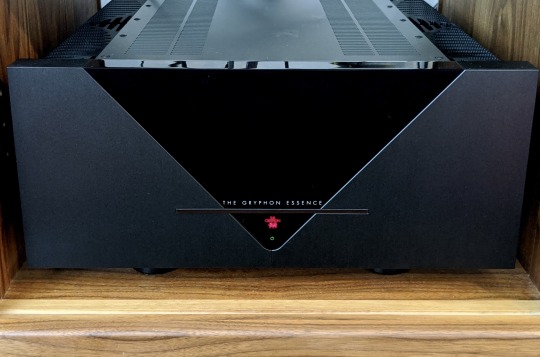
Coming from the Pass XA30.5, the Essence’s midrange was less overtly warm but even more substantive in tone. The Pass is certainly on the warm and lush side for a solid state amp, but past Gryphons I’ve heard had their own dose of chocolatey richness, so I was initially surprised by the balance of the Essence. It has the midrange density and lush tonal colors I was expecting from a Class A Gryphon amp, and yet it also sounds close to dead neutral in character. There’s a crystalline transparency that makes everything else sound a bit cloudy by comparison. Class A amps usually get the tonal part right, but can sound a bit sluggish or rounded dynamically; Class AB amps often have great transient speed but with some roughness around the edges and a bit of tonal hollowness. The Essence backs its exceedingly snappy and clean transients with real tonal substance and an infinite palette of realistic tonal colors. It can simultaneously preserve the gravitas of a string bass ostinato, the glowing warmth of a French horn, the delicate nasality of an oboe and the ethereal lightness of a flute all in balance. Orchestral recordings have never sounded this vivid and realistic in my home.
An interesting display of the amp’s prowess was in violinist Hilary Hahn’s recording of the Vieuxtemps Violin Concerto (Qobuz). The album also contains Mozart’s popular “Turkish” concerto which probably gets most of the plays; the Vieuxtemps is infrequently performed and mostly known by violinists as a sort of advanced student concerto (yes, my teacher made me study it). Vieuxtemps was a Belgian virtuoso of the romantic era and while the concerto has its charms, its orchestration is rather clunky. This actually made for a fascinating sonic experience in the concerto’s orchestral exposition, where different instruments pass melodic fragments back and forth in somewhat disjointed fashion rather than the more cohesive harmonization and counterpoint you’d get from a German master. A flute here, a clarinet there, a timpani roll or violin flourish coming and passing - the Essence conveyed each one with striking clarity and trueness of timbre and dynamics, arranging all the instruments across the stage in perfect proportion. So much of the feel of an instrument lies not just in its tonal makeup but the shape and feel of its notes - the reedy breathiness of a clarinet, the ringing “bong” of a timpani, the firm attack of a trumpet, the brush stroke of a violin. This is where the Essence’s leading-edge precision and lack of electronic haze help it truly evoke the feeling of sitting on the stage with the musicians, each and every instrumental entrance having that tactile realism.
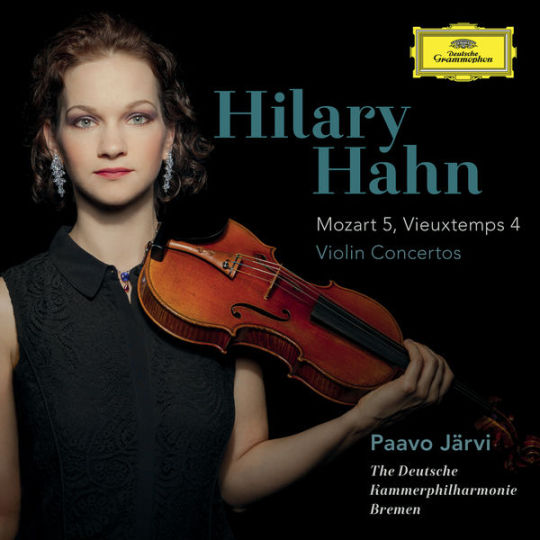
Having been a classmate’s of Ms. Hahn’s I also have first-hand experiences of her playing, and the Essence strongly evoked memories of hearing her performing in recitals or practicing in our conservatory. Though we were both teenagers at the time, she had already developed her distinctive tone and focused intensity, and hearing that reproduced so vividly through the Essence and Audiovector speakers is uncanny.
The frequency extremes of the Essence amp, particularly in combination with the Essence preamp, are also something special - the crazy-wide specified bandwidth of Gryphon components is no joke. The speed and tautness and slam of the bass brings realistic clarity to the foundation of the music. It’s bass that I like to call “sneaky” for the way it doesn’t unduly call attention to itself, but then will come out and smack you in the face as in a live event. Instruments like string bass or contrabassoon are naturally portrayed in the orchestration, rather than getting buried in the mix. The top end is extended and articulate, capable of bringing out all the energy and brilliance of string, brass and percussion instruments, and yet certain recordings that tend towards brightness actually sound warmer and smoother than I've heard before. It sounds so pure and free from distortion, so that if there’s any distortion already present on the recording it does nothing to aggravate it. Sibilants and tape hiss and clipping are still there, yet come across less obtrusively, making them easy to tune out in favor of the music.
Case in point: the DSD remaster of Strauss Don Juan, recorded in 1958 by the Cleveland Orchestra under George Szell (Qobuz). My wife and I have listened to this recording dozens if not hundreds of times and while the performance is riveting, the recording quality has always been a bit hissy and strident. My wife asked to listen to it again on the Gryphon setup for study purposes and halfway through I remarked, "does this recording sound a lot less bright to you?" She concurred - we had never heard it sound so clean and natural, and for the first time I didn't notice the tape hiss at all. The Gryphon gear really does excel at extracting the essence of the musical performance locked in the recording, neither artificially filtering nor amplifying the distractions of its mechanical limitations. I’ve heard far too many ultra high-end systems that need absolutely pristine audiophile material to sound their best. With the Gryphons, every recording in my collection has never sounded more distinguished and compelling.
The sense of space that the Essence preamp conveyed with other amplifiers becomes even stronger in combination with the Essence amp. I have never heard the different sections of a symphony orchestra arranged so palpably. Winds and percussion have clearly delineated space behind the string section, and delicate clarinet solos that are typically a bit hazy in recordings are conveyed with both clarity and intimacy. There’s something about the Essence’s blend of clean transients, tonal rightness and harmonic resolution that bring out the distinct ambience and texture of each recording - the aural equivalent of the “mouth feel” of a wine. Going back to otherwise excellent amps makes everything feel a bit more homogenous, a hair less stimulating.

There are a couple of potential shortcomings to call out, and they may be interrelated. The first is that the bass in combination with the Audiovector speakers isn’t quite as hard-hitting as with, say, the 600wpc Class D Legacy iv2, or as what I heard with the Gryphon Diablo 300 integrated; nor is it as plump and room-filling as with the Pass XA30.5. Quality-wise it’s exceptional - fast and deep and pitch-perfect in ways they can’t match - but sometimes I just want it to fill out the space a bit more and punch me in the gut a little harder. I mostly miss this when listening to pop tracks, e.g. anything from Billie Eilish where the raw punch of the Legacy amp factors more strongly than the n-th degree of refinement from the Gryphon.
The other nit is that the soundstage, while vividly painted, feels a bit less “generous” than bigger-sounding amps like the Legacy or Pass Labs, or the Gryphon Diablo for that matter. There’s a bit more emphasis on the precise constituency of an orchestra, as opposed to its sheer scale - a little more of the trees, a little less of the forest. To some, this may make the Essence feel a hair light in presentation, despite its rich and layered midrange. Ears I trust tell me moving up the Gryphon line to the Antileon EVO or Mephisto can give you the best of both worlds, but those are obviously at increasingly exorbitant price points.
I’ll need to try tweaking these area of reproduction more (e.g. cables), but as it currently stands, I could see the Essence best matching with speakers that are tonally richer and a bit less critically damped on the bottom end, vs. requiring care with something leaner and more laser-focused. It’s slightly lean with some recordings on the Audiovectors, and I’d definitely want to check before paring it with the likes of a Magico. It goes without saying that when you get to this level of fidelity (and cost), you should expect to spend a fair amount of time and effort on component matching.
As a side note, I was able to further extend the capabilities of the Essence via Furutech’s DPS-4.1 power cord (custom built with 20A connectors) and DSS-4.1 speaker cables. These upped the clarity and transparency yet another notch or three, opened up dynamics further and created a wider sense of space on recording after recording. I’ll have more on these excellent cables and how they synergize with the Gryphons in a future installment.
Capturing the Essence

It’s been challenging pinning down the character of the Essence system, the amp in particular. Even more so than other great Class A amps I’ve heard, including from Gryphon, the Essence amp has a combination of purity, openness, refinement, clarity, speed and dynamic life that defy the usual idiosyncrasies and limitations of Class A vs. AB vs. D. It’s dynamically fleet, rhythmically incisive, tonally sophisticated, dimensionally resolving, and sneakily powerful and punchy. In combination with the superb companion preamp, it uncovers a sense of space in virtually every recording I throw at it with greater detail and palpability than I’ve heard before, without seeming artificially holographic like some tube amps. The tonal purity and resolving power of this pair are simply at a level I have rarely experienced anywhere at any price. Moreover, the name “Essence” couldn’t be more apt - all these sophisticated qualities are squarely focused on conveying the beauty and quirks of the original recording without need for enhancement or editorializing to make it enjoyable. The closest aural recollection I have of this sort of musical resolution was the MSB Reference + Magico M3 system at RMAF 2018, which had a significantly superior DAC and a total cost approaching $300k.
As for the price... well, I can say that the monies spent on a piece by The Gryphon clearly go towards obsessive engineering and craftsmanship in the service of state-of-the-art music reproduction, rather than ostentation or frivolous excess. This is musical fidelity of the highest order, and my new reference in amplification.
5 notes
·
View notes